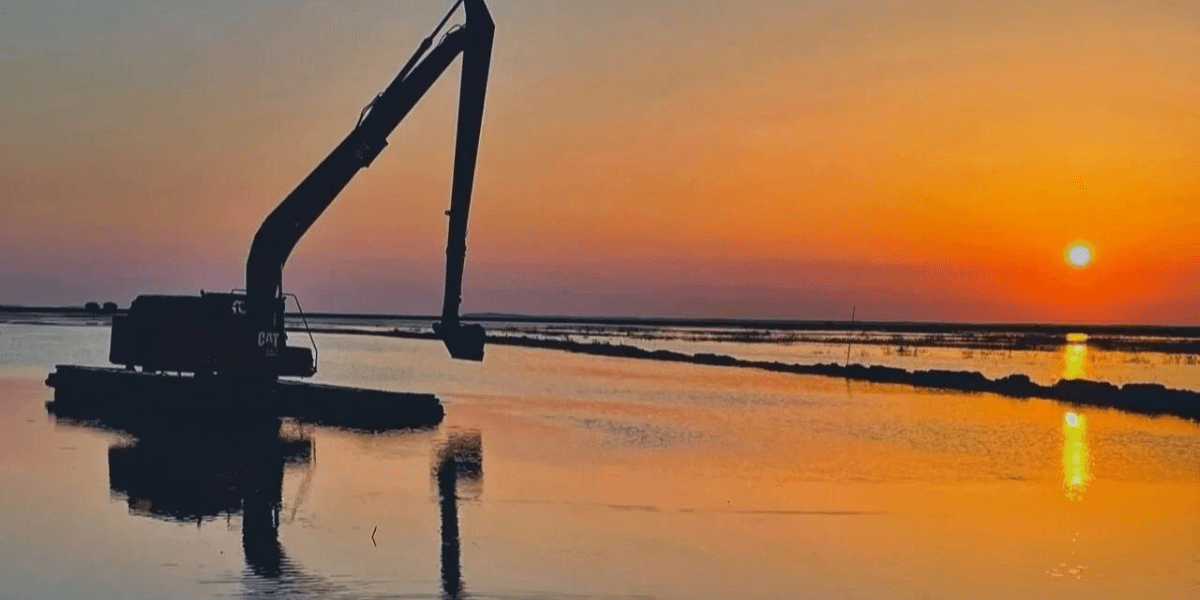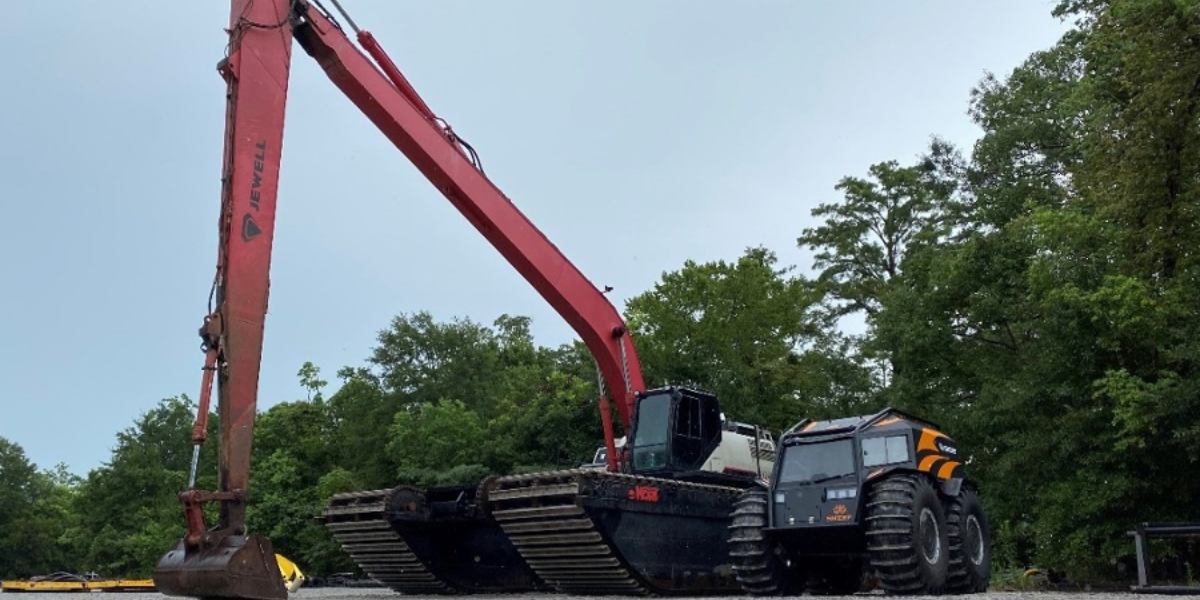Dredging & Marsh Buggies Role Mitigating Coastal Erosion in Louisiana
Coastal erosion (or the process where land is lost to the sea due to waves, currents, tides, glaciers, storms) is a big problem in many areas of the...
Dredging plays a vital role in maintaining the functionality and safety of our waterways, which are essential for global trade, transportation, and economic growth. It involves the removal of sediment and debris from the bottom of lakes, rivers, harbors, and other water bodies to ensure that they remain navigable for ships and boats.
Beyond navigation, dredging is crucial for flood prevention, environmental restoration, and the development of coastal infrastructure. While it has faced criticism for environmental impacts, the necessity of dredging is undeniable, making it imperative to adopt more responsible and sustainable practices to balance ecological preservation with the continued support of maritime activities.
Here are a few reasons why dredging is necessary, how this practice can be beneficial, and how it should be done correctly.

Like we talked about in our last post, coastal erosion is a process that breaks down the coastline. When something like a hurricane, cyclone, or tropical storm makes its way inland, it displaces the sand and sediment around the beach and deposits it elsewhere, usually in awkward places like sandbars located fairly far away from the coast.
As the water line creeps closer to the towns and inhabited areas, the risk of problematic flooding and damaging storms affecting the area begins to rise as well. The distance that the beaches create between the water and the towns serves as a protective barrier. If this distance doesn’t exist, the towns and infrastructure become more vulnerable.
Inland dredging combats against coastal erosion by depositing sand and sediment in places where erosion is most substantial. This effectively adds to the land and helps buffer against the effects of strong storms and flooding. When ocean dredging, it’s considered best practice to deposit sediment that is safe and uncontaminated so as not to disrupt the environment in that area.
Similar to coastal erosion, strong storms could also disrupt marine and beach habitats which often exist in the surrounding sand or gravel. When the habitats are disrupted, the wildlife is forced to relocate. This can cause issues in surrounding towns and can also put the wildlife at risk.
Inland dredging serves as a way to safely maintain the environments where the plant and animal life inhabits. Again, it’s especially crucial to only use dredged material that is safe and free of contaminants.
Dredging companies, when doing their job properly, pick up materials from specific areas and transport them to places that have been affected by storms and strong waves. Basically, it recreates the sand and dunes that have been eroded or destroyed.
One of the most prominent ways to import and export products is via ships and boats. When these vessels make their way inland, they dock at marinas. Because marinas are so close to land, they’re not nearly as deep as other parts of the ocean located farther off the coast.
Sometimes, the sediment at the bottom of marinas begins to concentrate in certain areas, making it difficult for ships and boats to navigate without getting stuck. That’s where dredging comes in.
Dredging companies either scoop or suck up the sediment and transfer it elsewhere. When doing this, it’s very important to not transfer materials such as garbage or contaminants, so as not to harm other environments.
At this point, you’re probably wondering what dredging companies do with the material that is contaminated. One of the best uses for contaminated sediment is to actually turn it into useful objects. Something that we regularly see is using the material to construct concrete and gravel. Not only is this a safe alternative to depositing the material in other areas, but it also takes out the polluted sediment from the marina.
There are quite a few reasons why it’s necessary to dredge, as long as it’s being done safely. Following protocols and never skimping on proper safety steps is important, especially when dealing with precious and fragile wildlife.
Dredging technology has grown more precise and more compact. This means that now dredge operators can now use smaller suction cutters or hydraulic dredges to displace mined materials and sort through them for gold.
In some cases, some miners make use of small backpack-sized dredges to quickly clear through material that larger machines would not be able to access.
U.S. Aqua Services offers the best dredging equipment for your coastal erosion and dredging needs. We stay abreast of all the changes in technology in order to offer you top-notch machinery that will get the job done quickly and efficiently. At U.S. Aqua, we understand that you need to stay on-time and on-budget, which is why we only use the best dredging equipment for the job.
Our team has over 100 years of combined dredging experience, meaning that if something unexpected happens during a job, we are able to quickly solve the issue and get moving again. We understand the importance of our job, and we ensure we are fully prepared with hard work and dedication to ensure your success.
If you are interested in our dredging or dredging equipment rental services, contact a team member today!
U.S. Aqua Services was created to support the dredging process in advancing commerce and responding to its many challenges. To accomplish this, our dredging company assembled an exceptional group of experienced individuals and a diverse inventory of dredge equipment.
We offer dredging equipment rental services so you can have access to the latest and greatest in dredging technology without having to pay to maintain it, transport, and store it, along with dewatering services.
With an emphasis on mobility, dependability, durability, diversity, efficiency, and safety, our dredging rental company can ensure that our different types of dredging systems are easy to move through any terrain and can work in the most rugged and remote environments. Our multi-function hydraulic systems are built with jetting and mechanical options that can efficiently move loose sediment or stiff layers of clay.
US Aqua services also and maintains a ready fleet of Amphibious Marsh Equipment capable of completing projects in some of the harshest and most remote environments. U.S Aqua is also the dealer for Louisiana of the amphibious vehicle Fat Truck. No matter the size or scope of the job or the remoteness of your work location, you can rely on Fat Truck’s industrial off-road utility vehicles to get the job done right.

Coastal erosion (or the process where land is lost to the sea due to waves, currents, tides, glaciers, storms) is a big problem in many areas of the...

Dredging is a common practice used by many for important services, such as cleaning out river bottoms for safer voyages by boats, exploring for sea...
You can think of dredging as moving subsea sediments and debris from one place to another, and in the case of dredging, these sediments and debris...